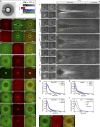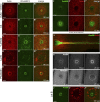Prepatterning by RhoGEFs governs Rho GTPase spatiotemporal dynamics during wound repair
- PMID: 28923977
- PMCID: PMC5716286
- DOI: 10.1083/jcb.201704145
Prepatterning by RhoGEFs governs Rho GTPase spatiotemporal dynamics during wound repair
Abstract
Like tissues, single cells are subjected to continual stresses and damage. As such, cells have a robust wound repair mechanism comprised of dynamic membrane resealing and cortical cytoskeletal remodeling. One group of proteins, the Rho family of small guanosine triphosphatases (GTPases), is critical for this actin and myosin cytoskeletal response in which they form distinct dynamic spatial and temporal patterns/arrays surrounding the wound. A key mechanistic question, then, is how these GTPase arrays are formed. Here, we show that in the Drosophila melanogaster cell wound repair model Rho GTPase arrays form in response to prepatterning by Rho guanine nucleotide exchange factors (RhoGEFs), a family of proteins involved in the activation of small GTPases. Furthermore, we show that Annexin B9, a member of a class of proteins associated with the membrane resealing, is involved in an early, Rho family-independent, actin stabilization that is integral to the formation of one RhoGEF array. Thus, Annexin proteins may link membrane resealing to cytoskeletal remodeling processes in single cell wound repair.
© 2017 Nakamura et al.
Figures





Similar articles
-
Rho family GTPases bring a familiar ring to cell wound repair.Small GTPases. 2015;6(1):1-7. doi: 10.4161/21541248.2014.992262. Small GTPases. 2015. PMID: 25862160 Free PMC article.
-
A potential Rho GEF and Rac GAP for coupled Rac and Rho cycles during mesenchymal-to-epithelial-like transitions.Small GTPases. 2021 Jan;12(1):13-19. doi: 10.1080/21541248.2018.1502592. Epub 2018 Aug 29. Small GTPases. 2021. PMID: 30032715 Free PMC article.
-
Rac1 is a novel interactor of Drosophila guanine nucleotide exchange factor GEFmeso.Mol Cell Biochem. 2015 Jun;404(1-2):259-62. doi: 10.1007/s11010-015-2385-3. Epub 2015 Mar 10. Mol Cell Biochem. 2015. PMID: 25753922
-
Rho activation at a glance.J Cell Sci. 2007 Apr 1;120(Pt 7):1149-52. doi: 10.1242/jcs.03428. J Cell Sci. 2007. PMID: 17376960 Review. No abstract available.
-
Rac 'n Rho: the music that shapes a developing embryo.Dev Cell. 2001 Sep;1(3):321-31. doi: 10.1016/s1534-5807(01)00053-3. Dev Cell. 2001. PMID: 11702944 Review.
Cited by
-
The kinesin-like protein Pavarotti functions noncanonically to regulate actin dynamics.J Cell Biol. 2020 Sep 7;219(9):e201912117. doi: 10.1083/jcb.201912117. J Cell Biol. 2020. PMID: 32673395 Free PMC article.
-
Scar/WAVE has Rac GTPase-independent functions during cell wound repair.Sci Rep. 2023 Mar 23;13(1):4763. doi: 10.1038/s41598-023-31973-2. Sci Rep. 2023. PMID: 36959278 Free PMC article.
-
Coordinated efforts of different actin filament populations are needed for optimal cell wound repair.Mol Biol Cell. 2023 Mar 1;34(3):ar15. doi: 10.1091/mbc.E22-05-0155. Epub 2023 Jan 4. Mol Biol Cell. 2023. PMID: 36598808 Free PMC article.
-
Mask, a component of the Hippo pathway, is required for Drosophila eye morphogenesis.Dev Biol. 2020 Aug 1;464(1):53-70. doi: 10.1016/j.ydbio.2020.05.002. Epub 2020 May 25. Dev Biol. 2020. PMID: 32464117 Free PMC article.
-
Autocrine insulin pathway signaling regulates actin dynamics in cell wound repair.PLoS Genet. 2020 Dec 11;16(12):e1009186. doi: 10.1371/journal.pgen.1009186. eCollection 2020 Dec. PLoS Genet. 2020. PMID: 33306674 Free PMC article.
References
MeSH terms
Substances
Grants and funding
LinkOut - more resources
Full Text Sources
Other Literature Sources
Molecular Biology Databases
Research Materials

